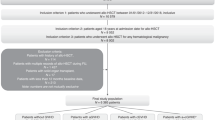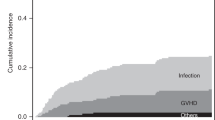Abstract
Hematopoietic SCT (HSCT) is one treatment modality for hematological malignancies. It is increasingly common but remains centralized in certain hospitals wherein procedures and protocols can vary. This study examined 100-day readmission for patients with hematological malignancies undergoing HSCT in Taiwan from the years 2001 to 2006. Of particular interest was an examination of how HSCT program characteristics might influence outcomes. This population-based retrospective cohort study with longitudinal follow-up used Taiwan's National Health Insurance Research Database. A generalized linear model with a logistic-dependent variable representing being admitted or not admitted was used to model 100-day readmission, adjusting for the nested design. There were 718 HSCT recipients for hematological malignancies in the 5-year study period from 10 HSCT programs. In spite of the average length of stay of 43.71 days (s.d.=25.75) days, 52% of recipients were readmitted within 100 days of discharge. Ownership status, the number of HSCT hematologists, and the ratio of HSCT procedures to HSCT hematologists independently predicted 100-day readmission after adjusting for clustered data and controlling for recipient characteristics.
This is a preview of subscription content, access via your institution
Access options
Subscribe to this journal
Receive 12 print issues and online access
$259.00 per year
only $21.58 per issue
Buy this article
- Purchase on Springer Link
- Instant access to full article PDF
Prices may be subject to local taxes which are calculated during checkout

Similar content being viewed by others
References
Pasquini M, Wang Z, Schneider L . Current use and outcome of hematopoietic stem cell transplantation: part I–CIBMTR summary slides, 2007. CIBMTR Newsletter 2007; 13: 5–9. Available from http://www.cibmtr.org/ReferenceCenter/Newsletters/Pages/index.aspx (Accessed 25 May 2008).
Jones JA, Qazilbash MH, Shih Y-C, Cantor SB, Cooksley CD, Elting LS . In-hospital complications of autologous hematopoietic stem cell transplantation for lymphoid malignancies. Cancer 2008; 112: 1096–1105.
Saito AM, Cutler C, Zabrieh D, Soiffer RF, Ho VT, Alyea EP et al. Costs of allogeneic hematopoietic cell transplantation with high-dose regimens. Biol Blood Marrow Transplant 2008; 14: 197–207.
Mitchell PH, Ferketich S, Jennings BM . Quality health outcomes model. Image J Nurs Scholarship 1998; 30: 43–46.
Andersen R, Rice T, Kominski G . Changing the US Health Care System. Jossey-Bass: San Francisco, CA, 1996.
Grant M, Cooke L, Bhatia S, Forman SJ . Discharge and unscheduled readmissions of adult patients undergoing hematopoietic stem cell transplantation: implications for developing nursing intervention. Oncol Nurs Forum 2005; 32: E1–E8.
Moya R, Espigado I, Parody R, Carmona M, Marquez F, De Blas JM . Evaluation of readmission in hematopoietic stem cell transplant recipients. Transplant Proc 2006; 38: 2591–2592.
National Health Research Institute. National Health Insurance Research Database. 2003. 2008. Available from http://www.nhri.org.tw (Accessed 1 October 2008).
UCLA Academic Technology Services. (n.d.). Statistical computing seminars: survival analysis with SAS. Available from http://www.ats.ucla.edu/stat/sas/seminars/sas_survival/default.htm (Accessed 28 April 2009).
Iezzoni LI . Risk Adjustment for Measuring Healthcare Outcomes 3rd edn. Health Administration Press: Chicago, IL, 2003.
Farsi M . Changes in hospital quality after conversion in ownership status. Int J Health Care Finance Eco 2004; 4: 211–230.
Taiwan Joint Commission on Hospital Accreditation. Quality improvement is shown on. http://www.tjcha.org.tw/quality.asp?catid=5 (Accessed on 31 May 2009)..
Loberiza FR, Zhang M-J, Lee SJ, Klein JP, LeMaistre CF, Serna DS et al. Association of transplant center and physician factors on mortality after hematopoietic stem cell transplantation in the United States. Blood 2005; 105: 2979–2987.
Georgy M, Yonescu R, Griffin CA, Batista DA . Acute mixed lineage leukemia and a t(6;14)(q25;q32) in two adults. Cancer Genet Cytogenet 2008; 185: 28–31.
Jabbour E, Cortes J, Kantarjian HM, Giralt S, Jones D, Jones R . Allogeneic stem cell transplantation for patients with chronic myeloid leukemia and acute lymphocytic leukemia after Bcr-Abl kinase mutation-related imatinib failure. Blood 2006; 108: 1421–1423.
Lee K-H, Lee J-H, Choi S-J, Lee J-H, Kim S, Seol M et al. Bone marrow vs extramedullary relapse of acute leukemia after allogeneic hematopoietic cell transplantation: risk factors and clinical course. Bone Marrow Transplant 2003; 32: 835–842.
Rowley JD . Seminars from the University of Minnesota. Chromosome translocations: dangerous liaisons. J Lab Clin Med 1998; 132: 244–250.
Wang Y, Wu D, Sun A, Jin Z, Qiu H, Miao M et al. Allogeneic hematopoietic stem cell transplantation for patients with chronic myeloid leukemia in second chronic phase attained by imatinib after onset of blast crisis. Int J Hematol 2008; 87: 167–171.
Labonte L, Iqbal T, Zaidi MA, McDiarmid SA, Huebsch LB, Tay J et al. Utility of comorbidity assessment in predicting transplantation-related toxicity following autologous hematopoietic stem cell transplantation for multiple myeloma. Biol Blood Marrow Transplant 2008; 14: 1039–1044.
Taiwan Medical Record Management Association. The origin of the association. 2005. Available from http://www.tmra.org.tw/guide.asp?Source=source&item=1 (Accessed 9 May 2009).
Healthcare Cost and Utilization project (HCUP). HCUP comorbidity software version 3.3. 2008, April. Available from http://www.hcup-us.ahrq.gov/toolssoftware/comorbidity/comorbidity.jsp#download (Accessed 2 October 2008).
Acknowledgements
The authors appreciate dissertation committees of Drs Erika Friedmann, Jeanne Geiger-Brown and Lyn Murphy as well as NHIRD database mentors of Drs Chung-Yi Li and Yu-Tung Huang.
Author information
Authors and Affiliations
Corresponding author
Ethics declarations
Competing interests
The authors declare no conflict of interest.
Rights and permissions
About this article
Cite this article
Hsieh, SI., Johantgen, M., Hsu, LL. et al. Are structural characteristics of programs and hospitals associated with 100-day readmission of hematopoietic SCTs in Taiwan?. Bone Marrow Transplant 46, 1203–1209 (2011). https://doi.org/10.1038/bmt.2010.282
Received:
Revised:
Accepted:
Published:
Issue Date:
DOI: https://doi.org/10.1038/bmt.2010.282



